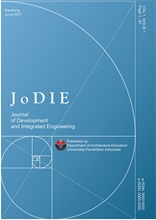STUDY OF CONTEMPORARY ARCHITECTURE ISSUES ON THE HIDDEN GEMS BAR TAMBLONG BAR CONCEPT IN A RESTAURANT THROUGH THE ADAPTIVE REUSE CONCEPT
Abstract
This article discusses how urbanity, the originality of a city is an attraction for tourists to visit a tourist destination. One of the studies that is being discussed is the bar concept in Tamblong restaurants and bars, called Hidden Gems Bar Tamblong which has a potential for study as a form of contemporary architectural development issues and also of course another impact function is as a business that will have a positive impact on helping the economic development of the local community, also has the potential to attract tourists to visit. The research method used is a qualitative descriptive research method.
Full Text:
PDFReferences
Andanwerti, N., Ismanto, A., and Fivanda, F. (2020). Penerapan konsep adaptive reuse pada desain interior café di kawasan kota lama semarang (studi kasus: tekodeko koffiehuis). Visuals. 15(1).
Andanwerti, N., Ismanto, A., and Fivanda, F. (2020).Application of the adaptive reuse concept in café interior design in the old town area of semarang (case study: tekodeko koffiehuis). Visuals, 15(1).
Angkouw, R., and Kapugu. (2012). Ruang dalam arsitektur berwawasan perilaku. Media Matrasain. 9(1):58–74.
Angkouw, R., and Kapugu. (2012). Space in behavioral architecture. Matrasain Media 9(1):58–74.
Astuti, S., and Hanan, H. (2012). The behavior of consumer society in consuming food at restaurants and cafes. Procedia - Social and Behavioral Sciences 42, 429-435.
Audrezet, A., De Kerviler, G., and Moulard, J. G. (2020). Authenticity under threat: When social media influencers need to go beyond self-presentation. Journal of business research, 117, 557-569.
Chen, R., Zhou, Z., Zhan, G., and Zhou, N. (2020). The impact of destination brand authenticity and destination brand self-congruence on tourist loyalty: The mediating role of destination brand engagement. Journal of Destination Marketing & Management, 15, 100402.
Cooffé, V. (2010). Le tourisme fabrique d'urbanité. Mondes du Tourisme, (2), 57-69.
Cravalho, N. D. (2015). Revitalization of 'dead space' through the use of interactive interventions. Doctor of Architecture 151, 10-17.
Dymnicka, M., and Badach, J. (2017). City and urbanity in the social discourse. In IOP Conference Series: Materials Science and Engineering, 245(4).
Garau-Vadell, J. B., Orfila-Sintes, F., and Batle, J. (2021). The quest for authenticity and peer-to-peer tourism experiences. Journal of Hospitality and Tourism Management, 47, 210-216.
Glancey, J. (2016). Hollow cities: purposeless towns. Architectural Review, 239(1432), 48-51.
Istiningrum, D. T., leidy Arumintia, R., Mukhlisin, M., and Rochadi, M. T. (2017). Kajian kenyamanan termal ruang kuliah pada gedung sekolah c lantai 2 politeknik negeri semarang. Wahana Teknik Sipil: Jurnal Pengembangan Teknik Sipil, 22(1), 1-16.
Istiningrum, D. T., leidy Arumintia, R., Mukhlisin, M., and Rochadi, M. T. (2017).Study of thermal comfort of classrooms in school building C floor 2 semarang state polytechnic. Civil Engineering Vehicle, 22(1):1–16.
Iveson, K. (2013). Cities within the city: Do‐it‐yourself urbanism and the right to the city. International Journal of Urban and Regional Research, 37(3), 941-956.
Kesgin, M., Taheri, B., Murthy, R. S., Decker, J., and Gannon, M. J. (2021). Making memories: a consumer-based model of authenticity applied to living history sites. International Journal of Contemporary Hospitality Management, 33(10), 3610-3635.
Machado, R. (1976). Old buildings as palimpsest. Towards a theory of remodeling. Progressive Architecture, 11, 46-49.
Macht, M., Meininger, J., and Roth, J. (2005). The pleasures of eating: A qualitative analysis. Journal of Happiness Studies, 6, 137-160.
Paulauskaite, D., Powell, R., Coca‐Stefaniak, J. A., and Morrison, A. M. (2017). Living like a local: Authentic tourism experiences and the sharing economy. International journal of tourism research, 19(6), 619-628.
Ram, Y., Björk, P., and Weidenfeld, A. (2016). Authenticity and place attachment of major visitor attractions. Tourism management, 52, 110-122.
Scott, N., Laws, E., and Boksberger, P. (2009). The marketing of hospitality and leisure experiences. Journal of Hospitality Marketing & Management, 18(2-3), 99-110.
Shao, D., Nagai, Y., Maekawa, M., and Fei. (2018). Innovative design typology for adaptive reuse of old buildings in public spaces. Journal of Engineering Science and Technology, 13(11), 3547-3565.
Shuqair, S., Pinto, D. C., and Mattila, A. S. (2019). Benefits of authenticity: Post-failure loyalty in the sharing economy. Annals of Tourism Research, 78, 102741.
Soewarno, N., and Permata, D. D. (2019). The transformation of heritage buildings as tourist attraction: adaptive re-use of colonial buildings at a bandung conservation area. In 18th International Conference on Sustainable Environment and Architecture (SENVAR 2018) , 156, 131-140.
Tandali, A. N., and Egam, P.P. (2011). Arsitektur berwawasan perilaku (behaviorisme). Media Matrasain, 8(1). 29-39.
Tandali, A. N., and Egam, P. P. (2011). Behavioral-oriented architecture (behaviorism). Matrasain Media, 8(1):29–39.
Yu, X., Huang, H., Liu, S. Q., and Lu, Z. (2020). Signaling authenticity of ethnic cuisines via handwriting. Annals of Tourism Research, 85, 103054.
DOI: https://doi.org/10.17509/jodie.v3i1.67795
Refbacks
- There are currently no refbacks.
Copyright (c) 2024 Indra Yudhapratama Kusumah, Asep Yudi Permana, M Syaom Barliana, Diah Cahyani Permana Sari

This work is licensed under a Creative Commons Attribution-NonCommercial-ShareAlike 4.0 International License.

This work is licensed under a Creative Commons Attribution-ShareAlike 4.0 International License.








